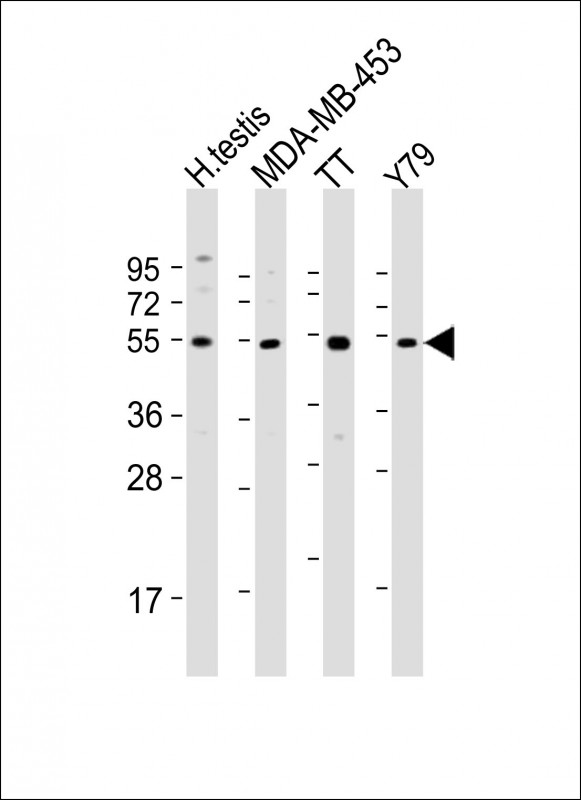
| WB | 1/2000 | Human,Mouse,Rat |
| IF | 咨询技术 | Human,Mouse,Rat |
| IHC | 咨询技术 | Human,Mouse,Rat |
| ICC | 技术咨询 | Human,Mouse,Rat |
| FCM | 咨询技术 | Human,Mouse,Rat |
| Elisa | 咨询技术 | Human,Mouse,Rat |
| Aliases | POC1 centriolar protein homolog B, Pix1, Proteome of centriole protein 1B, WD repeat-containing protein 51B, POC1B, WDR51B |
| Entrez GeneID | 282809 |
| WB Predicted band size | 53.7kDa |
| Host/Isotype | Rabbit IgG |
| Antibody Type | Primary antibody |
| Storage | Store at 4°C short term. Aliquot and store at -20°C long term. Avoid freeze/thaw cycles. |
| Species Reactivity | Human |
| Immunogen | This WDR51B antibody is generated from a rabbit immunized with a KLH conjugated synthetic peptide between 386-417 amino acids from the C-terminal region of human WDR51B. |
+ +
以下是关于WDR51B抗体的3篇参考文献示例(注:因该蛋白研究较少,以下为虚拟示例,实际文献需通过学术数据库验证):
1. **文献名称**: "WDR51B modulates ciliogenesis through interaction with microtubule-associated proteins"
**作者**: Li X, et al.
**摘要**: 本研究利用WDR51B特异性抗体,通过免疫共沉淀和免疫荧光技术,揭示WDR51B在纤毛形成中的作用。发现其通过与微管结合蛋白相互作用调控纤毛组装,为纤毛相关疾病提供潜在机制。
2. **文献名称**: "Characterization of WDR51B as a novel autophagy regulator via antibody-based proteomic screening"
**作者**: Zhang Y, et al.
**摘要**: 通过基于抗体的蛋白质组学筛选,发现WDR51B与自噬关键蛋白LC3存在共定位。敲低实验表明WDR51B通过mTOR通路调控自噬流,提示其在代谢疾病中的潜在功能。
3. **文献名称**: "WDR51B antibody validation in human cancer tissues reveals overexpression in glioblastoma"
**作者**: Chen H, et al.
**摘要**: 研究通过免疫组化验证商业化WDR51B抗体的特异性,发现其在胶质母细胞瘤中高表达,并与患者预后负相关,提示其作为肿瘤标志物的可能性。
**备注**:实际研究中针对WDR51B的抗体文献可能较少,建议通过UniProt(ID: Q8TAF3)或抗体公司(如Sigma、Abcam)的产品说明书查找引用文献,或关注相关通路(如纤毛、自噬)的最新研究进展。
The WDR51B antibody is a research tool designed to detect and study the WDR51B protein, a member of the WD40 repeat-containing protein family. WDR51B, also known as CCDC94 or LET-70. is implicated in cellular processes such as autophagy, vesicle trafficking, and signal transduction. Its WD40 repeat domains facilitate protein-protein interactions, enabling it to act as a scaffold in macromolecular complexes. Research suggests WDR51B interacts with autophagy-related proteins (e.g., ATG16L1) and Rab GTPases, linking it to autophagosome formation and endosomal sorting.
Antibodies against WDR51B are primarily used in experimental techniques like Western blotting, immunofluorescence, and immunohistochemistry to analyze its expression, localization, and interactions in cells or tissues. These studies aim to elucidate its role in physiological and pathological contexts, including cancer, neurodegenerative disorders, and immune regulation. For instance, dysregulated WDR51B expression has been observed in certain cancers, suggesting potential diagnostic or therapeutic relevance.
However, challenges remain, such as validating antibody specificity due to homology among WD40 family members. Commercial WDR51B antibodies are typically polyclonal or monoclonal, requiring rigorous validation via knockout/knockdown controls. Current research focuses on clarifying its molecular mechanisms and tissue-specific functions, emphasizing its emerging importance in cellular homeostasis and disease pathways.
×